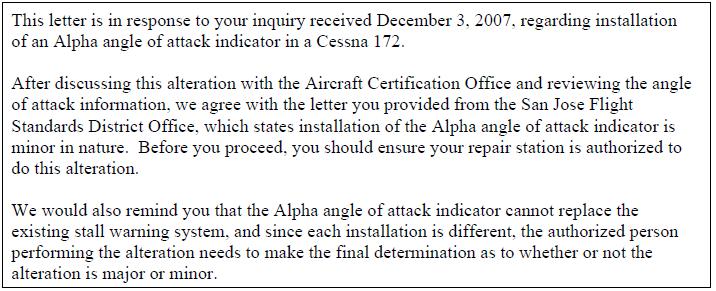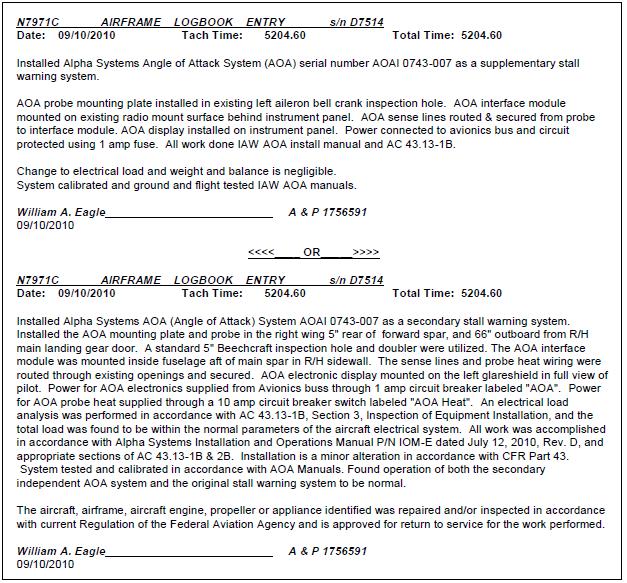Is the Legacy AoA system a "Minor Alteration," or is it "major"? The answer is: "It depends" ... but for the vast majority of general aviation aircraft it is indeed a Minor Alteration, requiring only a simple logbook entry by an A&P.
But first...
This formal FAA guidance got a lot clearer when the FAA Small Aircraft Directorate sent a Dec 15, 2011 letter of clarification to Alpha Systems. Please read this document; hugely important, it represents the very best of the FAA: great engineers and coherent logical thinking.
Then, on Feb 4, 2014, came a News Release from the FAA Admistrator and the Secretary of Transportation!
FAA Clears Path for Installation of Angle of Attack Indicators in Small Aircraft
Measure Could Improve Safety in Thousands of Aircraft.
Read it in its entirety here.
VERY RECENT, VERY IMPORTANT: June 2015--in the , the FAA is making a big push to get AoA indicators installed in General Aviation aircraft.
Always, it's important to keep in mind that it is UP TO THE INSTALLING A&P to determine what is a major alteration...because each installation will be slightly different.
For a much longer and more difficult way to answer the question (and reach the same conclusion that FAA-SAD did) ...the FAA guidance on this matter (here, read the entire FAA slideshow presentation to A&P mechanics) says that...
"A Major Alteration to an aircraft is one that might appreciably affect weight, balance,..." OK. Let's read the specific FAR defining a major alteration which says clearly in Part 43, Appendix A, (xi) that major alterations are those that create "...changes to the empty weight or empty balance which result in an increase in the maximum certificated weight or center of gravity limits of the aircraft."
COMMENT: Re-read that language carefully; it refers to modification of the ENVELOPE, not to ANY weight or CG shift. The lightweight (~2 pounds) Alpha System AoA creates only a negligible change in weight and balance; there is NO need to expand the envelope NOR request an increase in gross weight. It's easy to conclude that the Alpha System AoA Legacy or mechanical system is NOT going to have an appreciable effect on Weight and Balance.
"...structural strength, ... "
FORMULAE:
(Drag Coefficient) X (Frontal Area of Probe) X Vne² = Drag in LBS at Vne
.000327 X .064 X 200² = .83712
(Probe + Hardware Weight) X (Aircraft “G” Limit) X 1.5 (Safety Margin) = Additional Load
.83lbs X 4.0 X 1.5 = 4.98lbs.
COMMENT: The lightweight (.83 pounds) Alpha System AoA Legacy probe has an aft-force drag of under one (1) pound from airloads at 200Kts and a ~5 pound additional loading on a 4-G limited aircraft. These forces do not begin to cause any concern about structural deficiency. If a probe location must be created, all A&Ps agree that they can cut an inspection hole to have a look at something and cover it back up with an inspection hole cover, but when we then stick a probe out of that same hole - especially something that will impart a force on the skin via the moment created by the airloads, it is important to know that the additional loading on the skin is trivial...and in this case, it is.
"... performance, powerplant operation, flight characteristics, or other qualities affecting airworthiness; or that is not done according to accepted practices or cannot be done by elementary operations.
COMMENT: None of these apply to the Alpha System AoA probe or indicator.
Electrical Load? The basic Alpha System Legacy Display has a trivial current draw of less than one (1) amp; installations using the heated probe should calculate a formal Electrical Load Analysis. Both the 12 and the 24 volt heated probes draw 7.8 amps and the vast majority of aircraft electrical systems can easily carry such a load. An installing mechanic will use appropriate circuit protection, of course.
All of which is surely why the FAA experts at the FSDO wrote this to one installer:

This letter guidance represents common sense at its best; this one came from greatly-experienced FAA Air Safety Inspectors who took the trouble to double-check with the FAA Aircraft Certification Office (ACO) and ... guess what? ...the ACO is still saying the same thing today:
"It is UP TO THE INSTALLING A&P to determine what is a major alteration." The days when any/all modifications had to be pre-submitted to a local FSDO are long gone. So, if your A&P can find a workmanlike way (under AC 43.13-1B) to install the AoA system as a minor alteration, go right ahead and do it, using approved methods, etc. The FAA knows perfectly well that this device will save a lot of lives.
LOG ENTRY? We have seen many, but most of them look something like these ...

Please click here for locations to mount the Alpha probes, the sensors....
... and here are some good locations to mount the AoA displays
Read comments from pilots with recent fight experience using this particular AoA device, with AoA flight time in military aircraft, and in using AoA devices in general aviation aircraft. Read what a few Flight Instructors and Pilot Examiners think about it. As you read along, please notice that all are pilots with great experience...the most highly skilled among us...and ... EVERY ONE of them is savvy enough and humble enough to know that there are VERY GOOD REASONS for having an Angle of Attack indicator on the glareshield. Here is a list of all the AoA manufacturers that I'm aware of.
|






